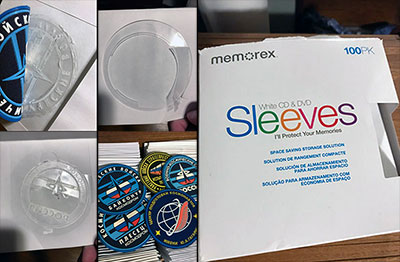|
|

|
|
Author
|
Topic: How NOT to store PVC space patches
|
edorr
Member Posts: 74
From: Chelmsford, MA
Registered: Oct 2000
|
 posted 10-31-2020 04:46 PM
posted 10-31-2020 04:46 PM
  
I just had a slightly scary experience I wanted to share with this group. I store almost all my patches in variations of CD sleeves. My best patches are in archival sleeves and boxes I get from Light Impressions. My run-of-the-mill patches go in paper CD sleeves with a cellophane-like transparent front — your average office-supply store CD sleeves. I've never had any issues with these sleeves until today. A few months ago I transferred my Soviet/Russian patches from notebook sleeves to these paper sleeves. When I happened to look in that collection today I discovered that the Russian patches that are made of some kind of rubberized material on cloth had disintegrated the transparent front of the sleeve. Luckily, the patches seemed to be undamaged, and I was able to peel the remnants of the cello-like material from the patches. Anyway, I just wanted to share this with you all, as I know there have been questions about how to store patches. This is definitely not the way to store rubberized patches!!  |
SXPatches
Member Posts: 50
From: Port Orchard, WA USA
Registered: Jul 2020
|
 posted 10-31-2020 10:04 PM
posted 10-31-2020 10:04 PM
   
Thank you for sharing. I have taken to storing my patches in clear cellophane wrappers. I have wondered if there are any risks to my patches by storing them in cellophane, knowing that chemical interactions between materials is always possible. |
Paul J. Brennan
Member Posts: 152
From: Linden, CA
Registered: May 2019
|
 posted 10-31-2020 11:58 PM
posted 10-31-2020 11:58 PM
   
Seconded, thanks! Perhaps acid-free Mylar bags/sleeves, and stored upright? Definitely keep out of direct and even indirect sunlight. |
edorr
Member Posts: 74
From: Chelmsford, MA
Registered: Oct 2000
|
 posted 11-02-2020 01:21 PM
posted 11-02-2020 01:21 PM
  
quote:
Originally posted by Paul J. Brennan:
Perhaps acid-free Mylar bags/sleeves, and stored upright? Definitely keep out of direct and even indirect sunlight.
The ones I pictured were, in fact, stored upright in a closed box in a usually dark room, so sunlight and heat were not factors. I had previously stored them in notebook-format plastic CD sleeves with no adverse consequences. |
mf451
Member Posts: 68
From: NY, NY
Registered: Nov 2014
|
 posted 11-02-2020 02:55 PM
posted 11-02-2020 02:55 PM
   
I've been using these archival print storage pages in the 4x6 sizes, to store most of my patches, with success. Might be worth a try, if the sizes work for you? |
SXPatches
Member Posts: 50
From: Port Orchard, WA USA
Registered: Jul 2020
|
 posted 11-03-2020 03:36 AM
posted 11-03-2020 03:36 AM
   
quote:
Originally posted by edorr:
I discovered that the Russian patches that are made of some kind of rubberized material on cloth had disintegrated the transparent front of the sleeve.
I did some research and a plasticizer is added to PVC plastic materials to make the plastic soft and flexible in order to make modern molded patches. This plasticizer will outgas (release chemicals into the air) for a period of time, especially for newly manufactured products. The chemicals released into the air act as a solvent, breaking down other materials, like plastic, during prolonged direct contact or confined exposure. Cellophane is impermeable to gases. Best to store your PVC patches in a well ventilated space for a period of time, maybe months, before storing them in your CD sleeves that have cellophane windows. Storing embroidered patches in a cellophane wrapper should pose no problem nor trigger a chemical reaction for conventional plastic backed patches. | |
Contact Us | The Source for Space History & Artifacts
Copyright 2020 collectSPACE.com All rights reserved.

Ultimate Bulletin Board 5.47a
|
|

|
 advertisement advertisement

|












